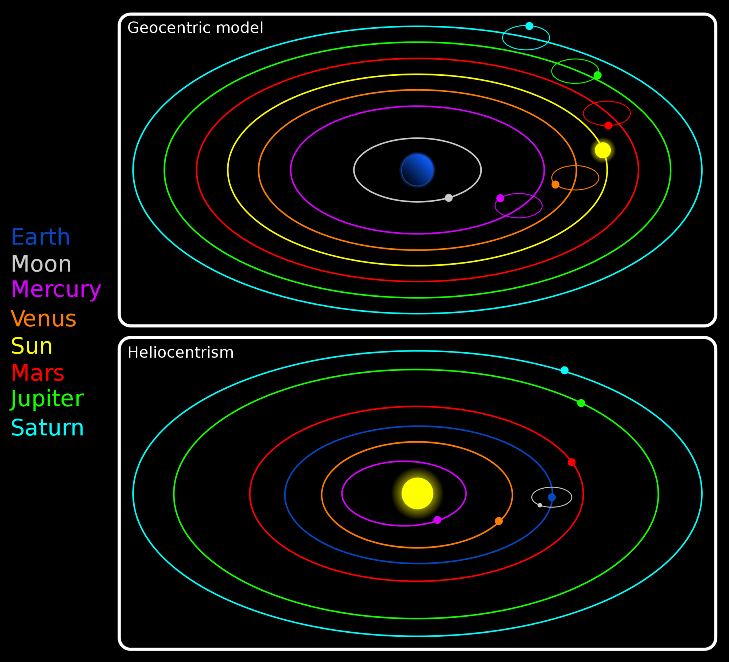

Today, I wanted to talk about the history of the heliocentric model. After all, Copernicus’ most notable accomplishment is probably his proposed heliocentric, or sun-centered, model for the universe.
Believe it or not, a mere 500 years ago, nearly everyone believed the heavens rotated around the Earth in a geocentric model rather than the universe revolving around the sun (yes, I intended to use the word ‘universe’ the Copernican model proposes that the sun is the center of everything – but more on that later).
Copernicus wasn’t the first scientists to propose a heliocentric model. The earliest mention of a sun-centered universe actually dates back to 200 BCE, to a man named Aristarchus of Samos. Other non-Earth centered models had been proposed around the same time (such as Philolaus’ ‘central fire’ model, which postulated all of the bodies in the universe revolved around a central fire – the fire isn’t the sun – in 390 BCE). Scientists had also figured out that the Earth must rotate to account for the fact that the stars ‘move’ around us.
Unfortunately, these ideas caved to Aristotle’s theories, where he provides three common sense arguments against a non-Earth centered model. These arguments are:
1) If the Earth was spinning, why don’t objects fly off the Earth?
2) If the Earth was moving around the sun, why doesn’t leave flying birds behind?
3) and finally, If the Earth was in orbit around the Sun, why don’t we see a parallax effect seen in the stars?
For those of you who know a bit about physics, I can hear you laughing now. But, remember that we didn’t understand the laws of motion until Newton in the 17th century, nearly 19 centuries after Aristotle. The first two parts of Aristotle’s argument are easily refuted with a modern understanding of motion. If you stand still, you have the illusion that you aren’t moving because everything around you is moving at the same speed. If you were in a plane with no window to look out of, and no noise to give away it away, you’d have no idea if you were actually moving or standing still – because everything inside the plane is moving at the same speed.

Seen above is an example of the Parallax effect. Unknown to Aristotle at the time, there is actually a parallax effect seen in the stars, it’s just extremely small. This particular objection doesn’t account for the vast distances in space.
Regardless, because of these objections, the Earth remained the center of the universe. In the second century CE, Ptolemy proposed a system that managed to predict the positions of the planets with unprecedented accuracy – even though the system continually had to be reset due to anomalies, it was the most accurate tool for prediction we had.
As an interesting side note, the Ptolemaic universe was very small, the distance to the stars was less than 20 Astronomical Units (or, less than two-thirds the distance to Neptune). Over time, the model was improved upon and it increasingly became more accurate when it came to predicting the motions of the planets. There was one strong issue with the Ptolemaic model – it didn’t adequately explain the retrograde motions of the planets, even with epicycles.
This is what lead Copernicus to propose the heliocentric model. If you put the sun at the center, and have the other planets rotate around it, the apparent retrograde motion is explained by Earth overtaking the more distant planets as it travels around the sun.
See an example here:

The Copernican heliocentric model wasn’t much more accurate than the Ptolemaic geocentric model – it didn’t even do away with the need for epicycles. The Copernican system was, however, much simpler. It used fare fewer epicycles than the Ptolemaic counterpart. The epicycles were still a pesky annoyance because the planets were thought to move around the sun in a uniformly circular motion. At the end of his life, Copernicus published his book De Revolutionibus Orbium Coelestium (On the Revolutions of Heavenly Spheres). He probably chose this timing to protect himself from the ridicule of his peers and the Church who thought VERY strongly of Aristotelian philosophy.
It wasn’t until Kepler, Galileo, and Newton came onto the scene in the seventeenth century, nearly a hundred years after Copernicus’ death, when his model of the universe actually started to be taken seriously. These three scientists managed to provide strong evidence for a heliocentric universe. Newton and Kepler laid down a mathematical foundation to explain the motions of the planets with extreme precision, Galileo collected mountains of observational evidence both supporting heliocentrism and challenging Aristotelian thinking.
Of course, today we know without a shadow of a doubt that the Earth revolves around the sun.